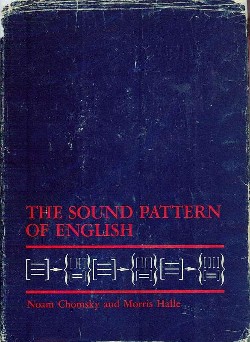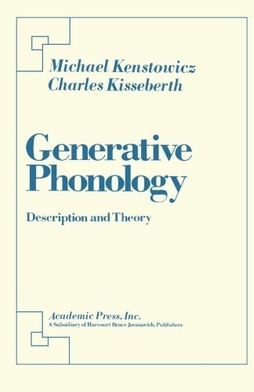Related Research Articles
Phonology is the branch of linguistics that studies how languages systematically organize their phones or, for sign languages, their constituent parts of signs. The term can also refer specifically to the sound or sign system of a particular language variety. At one time, the study of phonology related only to the study of the systems of phonemes in spoken languages, but may now relate to any linguistic analysis either:
In linguistics, syntax is the study of how words and morphemes combine to form larger units such as phrases and sentences. Central concerns of syntax include word order, grammatical relations, hierarchical sentence structure (constituency), agreement, the nature of crosslinguistic variation, and the relationship between form and meaning (semantics). There are numerous approaches to syntax that differ in their central assumptions and goals.

The Sound Pattern of English is a 1968 work on phonology by Noam Chomsky and Morris Halle. In spite of its title, it presents not only a view of the phonology of English, but also contains discussions of a large variety of phonological phenomena of many other languages. The index lists about 100 such languages. It has been very influential in both the field of phonology and in the analysis of the English language. Chomsky and Halle present a view of phonology as a linguistic subsystem, separate from other components of the grammar, that transforms an underlying phonemic sequence according to rules and produces as its output the phonetic form that is uttered by a speaker. The theory fits with the rest of Chomsky's early theories of language in the sense that it is transformational; as such it serves as a landmark in Chomsky's theories by adding a clearly articulated theory of phonology to his previous work which focused on syntax.
In linguistics, transformational grammar (TG) or transformational-generative grammar (TGG) is part of the theory of generative grammar, especially of natural languages. It considers grammar to be a system of rules that generate exactly those combinations of words that form grammatical sentences in a given language and involves the use of defined operations to produce new sentences from existing ones.

Generative grammar is a theoretical approach in linguistics that regards grammar as a domain-specific system of rules that generates all and only the grammatical sentences of a given language. In light of poverty of the stimulus arguments, grammar is regarded as being partly innate, the innate portion of the system being referred to as universal grammar. The generative approach has focused on the study of syntax while addressing other aspects of language including semantics, morphology, phonology, and psycholinguistics.
In linguistics, the minimalist program is a major line of inquiry that has been developing inside generative grammar since the early 1990s, starting with a 1993 paper by Noam Chomsky.

Syntactic Structures is an important work in linguistics by American linguist Noam Chomsky, originally published in 1957. A short monograph of about a hundred pages, it is recognized as one of the most significant and influential linguistic studies of the 20th century. It contains the now-famous sentence "Colorless green ideas sleep furiously", which Chomsky offered as an example of a grammatically correct sentence that has no discernible meaning, thus arguing for the independence of syntax from semantics.

John Robert "Haj" Ross is an American poet and linguist. He played a part in the development of generative semantics along with George Lakoff, James D. McCawley, and Paul Postal. He was a professor of linguistics at MIT from 1966 to 1985 and has worked in Brazil, Singapore and British Columbia, and until spring 2021, he taught at the University of North Texas.
In linguistics, linguistic competence is the system of unconscious knowledge that one knows when they know a language. It is distinguished from linguistic performance, which includes all other factors that allow one to use one's language in practice.
Frederick J. (Fritz) Newmeyer is an American linguist who is Professor Emeritus of Linguistics at the University of Washington and adjunct professor in the University of British Columbia Department of Linguistics and the Simon Fraser University Department of Linguistics. He has published widely in theoretical and English syntax and is best known for his work on the history of generative syntax and for his arguments that linguistic formalism and linguistic functionalism are not incompatible, but rather complementary. In the early 1990s he was one of the linguists who helped to renew interest in the evolutionary origin of language. More recently, Newmeyer argued that facts about linguistic typology are better explained by parsing constraints than by the principles and parameters model of grammar. Nevertheless, he has continued to defend the basic principles of generative grammar, arguing that Ferdinand de Saussure's langue/parole distinction as well Noam Chomsky's distinction between linguistic competence and linguistic performance are essentially correct.
The generative approach to second language (L2) acquisition (SLA) is a cognitive based theory of SLA that applies theoretical insights developed from within generative linguistics to investigate how second languages and dialects are acquired and lost by individuals learning naturalistically or with formal instruction in foreign, second language and lingua franca settings. Central to generative linguistics is the concept of Universal Grammar (UG), a part of an innate, biologically endowed language faculty which refers to knowledge alleged to be common to all human languages. UG includes both invariant principles as well as parameters that allow for variation which place limitations on the form and operations of grammar. Subsequently, research within the Generative Second-Language Acquisition (GenSLA) tradition describes and explains SLA by probing the interplay between Universal Grammar, knowledge of one's native language and input from the target language. Research is conducted in syntax, phonology, morphology, phonetics, semantics, and has some relevant applications to pragmatics.

Joan Lea Bybee is an American linguist and professor emerita at the University of New Mexico. Much of her work concerns grammaticalization, stochastics, modality, morphology, and phonology. Bybee is best known for proposing the theory of usage-based phonology and for her contributions to cognitive and historical linguistics.
Charles Reiss is an American linguistics professor teaching at Concordia University in Montreal.

Aspects of the Theory of Syntax is a book on linguistics written by American linguist Noam Chomsky, first published in 1965. In Aspects, Chomsky presented a deeper, more extensive reformulation of transformational generative grammar (TGG), a new kind of syntactic theory that he had introduced in the 1950s with the publication of his first book, Syntactic Structures. Aspects is widely considered to be the foundational document and a proper book-length articulation of Chomskyan theoretical framework of linguistics. It presented Chomsky's epistemological assumptions with a view to establishing linguistic theory-making as a formal discipline comparable to physical sciences, i.e. a domain of inquiry well-defined in its nature and scope. From a philosophical perspective, it directed mainstream linguistic research away from behaviorism, constructivism, empiricism and structuralism and towards mentalism, nativism, rationalism and generativism, respectively, taking as its main object of study the abstract, inner workings of the human mind related to language acquisition and production.
Formal semantics is the study of grammatical meaning in natural languages using formal tools from logic, mathematics and theoretical computer science. It is an interdisciplinary field, sometimes regarded as a subfield of both linguistics and philosophy of language. It provides accounts of what linguistic expressions mean and how their meanings are composed from the meanings of their parts. The enterprise of formal semantics can be thought of as that of reverse-engineering the semantic components of natural languages' grammars.
In linguistics, optimality theory is a linguistic model proposing that the observed forms of language arise from the optimal satisfaction of conflicting constraints. OT differs from other approaches to phonological analysis, which typically use rules rather than constraints. However, phonological models of representation, such as autosegmental phonology, prosodic phonology, and linear phonology (SPE), are equally compatible with rule-based and constraint-based models. OT views grammars as systems that provide mappings from inputs to outputs; typically, the inputs are conceived of as underlying representations, and the outputs as their surface realizations. It is an approach within the larger framework of generative grammar.
Liliane Madeleine Victor Haegeman ARB is a Belgian professor of linguistics at Ghent University. She received her PhD in English linguistics in 1981 from Ghent University, and has written numerous books and journal articles thereafter. Haegeman is best known for her contributions to the English generative grammar, with her book Introduction to Government and Binding Theory (1991) well established as the most authoritative introduction on the Principles and Parameters approach of generative linguistics. She is also acknowledged for her contributions to syntactic cartography, including works on the left periphery of Germanic languages, negation and discourse particles, and adverbial clauses. As a native speaker of West Flemish, her research has also touched upon the comparative study of English and West Flemish in terms of the subject position and its relation to the clausal structure.

Phonology in Generative Grammar is a 1994 book by Michael Kenstowicz in which the author provides an introduction to phonology in the framework of generative grammar.

Generative Phonology: Description and Theory is a 1979 book by Michael Kenstowicz and Charles Kisseberth in which the authors provides an introduction to phonology in the framework of generative grammar.
Henk van Riemsdijk is a Dutch linguist and professor emeritus at Tilburg University.
References
- ↑ doctoral dissertation
- ↑ "Michael Kenstowicz". MIT Linguistics.
- ↑ Hall, Tracy (1995). "Michael Kenstowicz: Phonology in Generative Grammar. Cambridge:Blackwell, 1994. 704pp". Linguistics. 33 (3). doi:10.1515/ling.1995.33.3.579.
- ↑ Szpyra, Jolanta (1 July 1995). "Phonology in Generative Grammar: M. Kenstowicz, Cambridge, MA and Oxford, UK: Blackwell, 1994. xi + 704 pp. UK £ 17.99 (pb.). ISBN 1-55786-426-8". Lingua. 96 (2): 189–195. doi:10.1016/0024-3841(95)90019-5. ISSN 0024-3841.
- ↑ Dinnsen, Daniel A. (May 1995). "Kenstowicz Michael (1994). Phonology in generative grammar. Cambridge, Mass. & Oxford: Blackwell. Pp. ix + 704". Phonology. 12 (1): 131–134. doi:10.1017/S0952675700002402. ISSN 1469-8188. S2CID 61581024.
- ↑ Parker, Steve (1995). "Phonology in generative grammar. By MICHAEL KENSTOWICZ. Cambridge, Massachusetts: Blackwell Publishers, 1994. Cloth $64.95, paper $24.95" (PDF). Notes on Linguistics (68).
- ↑ "Natural Language & Linguistic Theory". Springer.